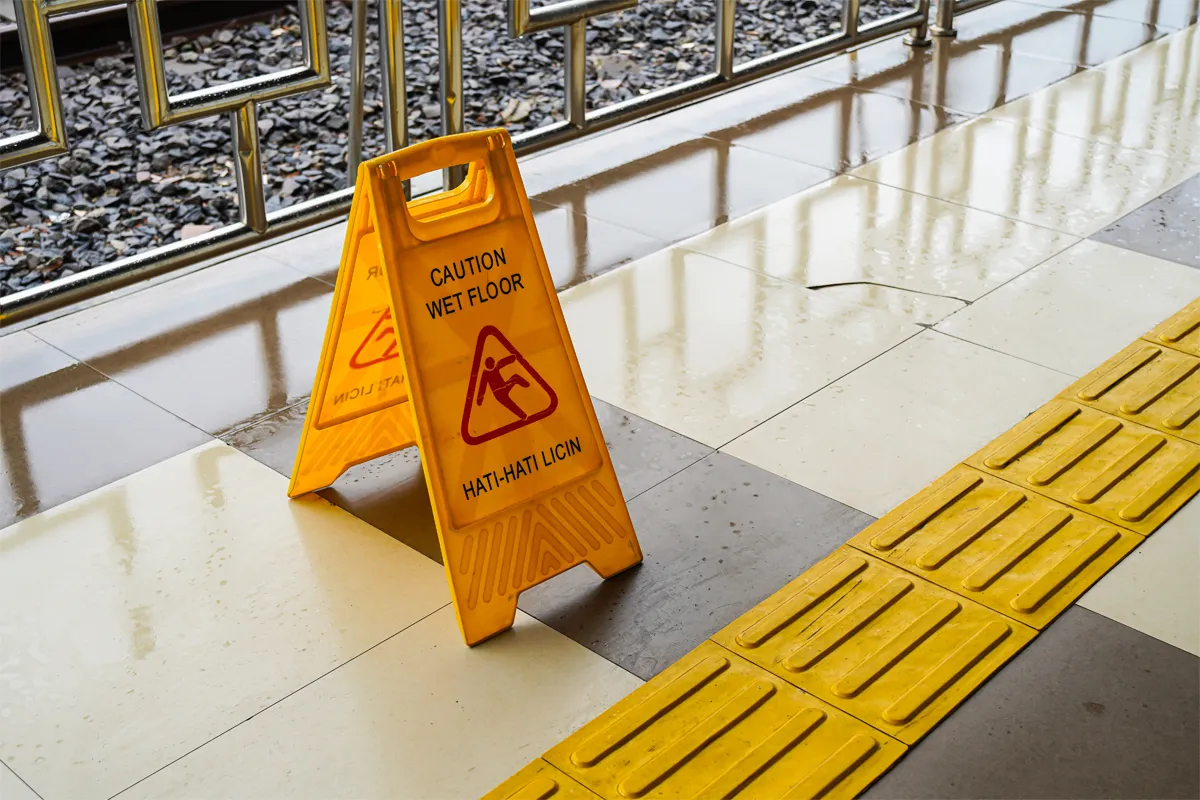Damages are paid to you to compensate you for the impact of injuries when another party is at fault for these injuries.
In Public Liability Claims, damages are calculated by considering economic and non-economic loss, looking at the severity of your injury and its impact upon your life.
Economic damages cover things like lost wages and superannuation contributions, medical expenses, and care provided by friends and family.
Non-economic damages (also known as general damages) address pain and suffering, and the impact on the injured person’s life. Victoria has specific guidelines for assessing general damages, requiring a “significant” injury and considering factors like pain, treatment, and permanent impairment.
An injured person will often ask their public liability lawyer, “how much money am I going to receive?”. Good lawyers should be able to provide a qualified response to this question reasonably early in your matter, though this is always subject to change as your injuries and matter progress.
Quick Links
How are Public Liability payouts calculated?
Damages payouts in Public Liability matters can be very complicated. They are worked out by assessing a great deal of factors in any given case and are generally categorised by the following:
The following is a detailed summary of how a good public liability lawyer will go about assessing your potential public liability claim. Usually, lawyers look at a few factors, such as the overall effects of an injury on a person, as well as what medical treatment a person has had to go through, and the lasting consequences of the injury.
It is important to find a lawyer that listens to you and will speak to you at length about the consequences upon you and your life in order to maximise a payout for pain and suffering damages.
The role of your lawyer is to support you through a difficult time of your life, to listen to you, and to achieve the best outcome we can based upon your instructions, and what is realistic in accordance with the provisions of the Wrongs Act 1958 and guiding case law.
-- Arnold Dallas McPherson
Pain and Suffering Damages
Pain and suffering damages are not only for your literal pain and suffering as a result of injury, but also for all the other ways that injuries affect you. We often refer to this as “loss of enjoyment of life”.
This includes a very wide range of things for any individual, such as not being able to enjoy your favourite hobbies or sports, having your sleep or mobility affected, or even simply not being able to look after your family in the normal way.
In order to be able to claim pain and suffering damages for a public liability injury, the law in Victoria currently requires that you must establish that you have a ‘significant injury’ before you can sue for pain and suffering damages.
A ‘significant injury’ means an injury which has resulted in a permanent whole person impairment, as assessed by doctors under the American Medical Association Guides (‘the AMA Guides’) to the Evaluation of Permanent Impairment (4th Edition), as:
- For spinal injuries, a 5% or more whole person impairment; or
- For all other physical injuries, a greater than 5% whole person impairment; or
- For psychological injuries, a 10% or more whole person impairment.
An impairment is usually only seen as permanent if it is not expected to improve with further medical treatment.
A good lawyer will be able to give you advice on whether your injury is likely to meet the relevant ‘significant injury’ threshold. Your treating GP or surgeon is unable to perform the impairment assessment for you. Instead, your lawyer will arrange a medicolegal examination appointment with a doctor who has undertaken specialist training in assessing permanent impairment under the AMA Guides.
In Victoria, the maximum compensation for non-economic loss is currently $759,510 (this figure is tied to indexation and increases each year on July 1). While the AMA Guides are an important gateway to an entitlement to claim pain and suffering damages, there is no real guide as to how to calculate pain and suffering damages. All people are different, and the same injuries might have very different effects on two separate people.
Note: We have changed the names of examples below for privacy reasons.
EXAMPLE ONE - Pain and Suffering Damages
Margaret (52 - Supermarket Cashier)
Suffered injury to her right hip when she tripped and fell on cracked bitumen
Margaret was a 52 year old supermarket cashier, who suffered injury to her right hip when she tripped and fell on cracked bitumen on her local council’s footpath. The council had identified that the cracked bitumen was a tripping hazard before Margaret suffered her fall, yet they had unfortunately failed to do any repair work. She ultimately underwent a total hip replacement. Margaret continues to experience daily pain and is restricted in her ability to undertake normal tasks in her daily life. She has had to give up her hobbies of gardening and playing tennis with her friends.
As she is facing a likelihood of another total hip replacement and given her relatively young age, Margaret received a payout for her pain and suffering of $230,000.00.
PAYOUT AMOUNT
$230,000.00
EXAMPLE TWO - Pain and Suffering Damages
Jill (69 - Retired Pensioner)
Suffered fractures to both her wrists when she fell down poorly lit stairs at a motel
Jill was a 69 year old retired pensioner who suffered fractures to both her wrists when she fell down poorly lit stairs at a motel where she was staying on holiday.
Jill had to wear casts on both wrists for 8 weeks, and needed help from her husband with using the toilet and showering. Her daughter would visit her daily to help around the house. She struggled to chop vegetables and open jars. Jill was restricted in his ability to care for her home and keep up with her grandchildren. She is no longer able to care for her 2 year old grandson one day a week.
Jill received a payout of $175,000 for her pain and suffering.
PAYOUT AMOUNT
$175,000.00
EXAMPLE THREE - Pain and Suffering Damages
David (57 - Truck Driver)
Suffered a lower back injury when he was crushed by a cow while delivering cattle at a sale yard
David was a 57-year-old self-employed truck driver who suffered a lower back injury when he was crushed by a cow while delivering cattle at a sale yard. The owner occupier of the sale yard had failed to install a safety gate which would have prevented David’s injury.
David underwent spinal fusion surgery. David’s doctors told him that his permanent work restrictions meant that he was unable to return to work with livestock, and he had to close his livestock transport business. David used to enjoy playing golf with his friends and looking after his 40 acre property. He is now looking at downsizing to a small unit so that he does not have to worry about maintaining lawns. At the time of the resolution of his case, David had been off work for 3 years.
David received a payout of $350,000 for his pain and suffering.
PAYOUT AMOUNT
$350,000.00
Economic Loss Damages
If you are unable to work as a result of your accident for a specified period of time or, tragically perhaps never able to work again, you can claim for past and future loss of income. This will be calculated on a net weekly basis and paid to you as part of your claim by way of lump sum. This includes lost superannuation contributions.
1. Past Lost Earnings and Superannuation Contributions
When making a public liability claim, unfortunately, unlike the WorkCover and TAC compensation schemes, you are unable to claim an upfront payment for the time you have had to take off work while recovering from your injuries. Instead, you are able to claim a lump sum payment for your past lost wages and superannuation contributions at the same time that you claim pain and suffering damages.
If you have income protection insurance, it is important to make a claim as soon as you can after your injury. Many people are unaware that they hold income protection or salary continuance insurance through their superannuation fund. Arnold Dallas McPherson can assist you with making enquiries as to any income protection insurance cover you may have, and preparing your income protection claim. Those income protection payments would then form part of your claim to be reimbursed in the event of a settlement.
EXAMPLE ONE - Past lost earnings and superannuation contributions
Margaret (52 - Supermarket Cashier)
Suffered injury to her right hip when she tripped and fell on cracked bitumen
Margaret was working part-time at the time of her injury, working 30 hours per week. Margaret was earning $550 each week after tax, plus receiving superannuation contributions of $70 (totalling $620).
Margaret was initially unable to work at all for a period of six months. She tried returning to work at 30 hours per week, but she would experience pain in her right hip after being on her feet for too long, and needed a rest day in between shifts. She returned to work at reduced hours of two 4 hour shifts a week, earning $160 per week, with $18 in superannuation contributions (totalling $178).
Her case settled 3 years after her injury.
—
Number of weeks unable to work x (pre injury weekly income + superannuation contributions) = past total loss
26 weeks x $620 = $16,120
—
Number of weeks working reduced hours x (pre injury earnings – reduced weekly income and reduced superannuation contributions) = past reduced loss
130 x ($620 – $178) = $57,460.00
PAYOUT AMOUNT
$73,580.00 for her past loss of earnings
EXAMPLE ONE - Past lost earnings and superannuation contributions
Jill (69 - Retired Pensioner)
Suffered fractures to both her wrists when she fell down poorly lit stairs at a motel
As Jill is a retired pensioner, she had no past lost earnings and superannuation contributions.
PAYOUT AMOUNT
No past economic loss damages awarded
EXAMPLE ONE - Past lost earnings and superannuation contributions
David (57 - Truck Driver)
Suffered a lower back injury when he was crushed by a cow while delivering cattle at a sale yard
David had been working full-time at the time of his injury earning $1,600 per week after tax, plus $241 in superannuation contributions.
He was forced to close his business after his injury. He attempted to find part-time work as a light delivery driver, but was unable to complete his shifts without aggravating his lower back pain. He was forced to retire early.
David made enquiries with his superannuation fund, and discovered that he was entitled to claim income protection payments for a period of 104 weeks, at a rate of $1,000 per week after tax.
At the time of resolution of his case, David had been off work for 4 years.
David was able to claim a reimbursement of the amount of income protection payments he had received from his superannuation fund’s insurance company, totalling $104,000. David was also able to claim the difference between what he would have earned ($1,600), and the income protection payments he received for 104 weeks.
—
Number of weeks unable to work x (pre injury weekly income + superannuation contributions) = past total loss
208 x (1,600 + $241) = $382,928
PAYOUT AMOUNT
David received a payout of $382,928 for his past loss of earnings, with $104,000 to be repaid to his superannuation fund’s insurance company
2. Future Economic Loss
Future economic loss claims can often be quite complicated. It involves predicting what the future might have looked like and how a person may recover in the future.
Catastrophically injured persons are often conceded to be a “total loss” of earning capacity, meaning they will not earn anything, as they will never work again.
Most people, however, are able to work in some capacity, either in their pre-injury role or another job that suits their skills and experience.
Consideration must be given to what a Court may accept as a likely scenario in the future about a person’s capacity to work.
The type of things the Court will look at are:
- Can the person work? If so, how much can they work?
- What are they able to earn now as opposed to before their injury?
- When would the person have retired and are there any other conditions which might have affected their retirement age?
You can also receive lump sum damages if there is a risk that your future capacity for work will be impacted because of your injury, even if you did not have any time off work. This can include working in a lower waged and less physically demanding job, reducing your work hours to accommodate your injury restrictions, or being forced to retire early. This is sometimes called a ‘Farlow’ amount, based upon a previous case.
It is very important that your lawyer gets full and proper instructions for their client. The lawyers at Arnold Dallas McPherson have a lot of experience in obtaining evidence regarding work capacity and advising clients realistically regarding their claims for economic loss.
Damages for future economic loss are calculated by looking at the weekly loss, multiplying this using an actuarial figure as to what each dollar is worth over time, and then taking away a percentage, typically 15%, for unforeseen events that might occur in the future to stop someone working. This reduction is known as the “vicissitudes of life”.
Superannuation is also usually factored in, at the compulsory rate of 12%.

Schedule a Free Call
Arnold Dallas McPherson offers a free initial consultation and provide services on a No Win, No Fee basis. We are experienced in all types of TAC claims and can advise quickly whether further compensation may be claimed based on your circumstances.
EXAMPLE ONE - Future Economic Loss
Margaret (52 - Supermarket Cashier)
Suffered injury to her right hip when she tripped and fell on cracked bitumen
Margaret instructed that she was intending on continuing to work full-time until the age of 67 years.
Margaret’s lawyers arranged for her to be examined by an occupational physician who opined that due to her right hip injury, she would need to cease work completely and retire early by age 60. Her claim for future loss of earnings was put on the basis that she would continue to work reduced hours to age 60, with a Farlow amount for her likely early retirement.
—
Number of weeks unable to work x (pre injury weekly income + superannuation contributions) = past total loss
$550 x 231.5 = $127,325
Less vicissitudes:
$127,325.00 x 0.85 = $108,226
Plus superannuation (12% = $12,987):
$108,226 + $12,987 = $121,213
—
Weekly net earnings if not injured including superannuation x Relevant multiplier between ages 60 and 67 years
$550 x 309.4 = $170,170
Less vicissitudes:
$191,828 x 0.85 = $144,644
Plus superannuation (12% = $17,357):
$144,644 + $17,357 = $162,001
PAYOUT AMOUNT
Margaret received a payout of $283,214 for her future loss of earnings
EXAMPLE TWO - Future Economic Loss
Jill (69 - Retired Pensioner)
Suffered fractures to both her wrists when she fell down poorly lit stairs at a motel
As Jill is a retiree pensioner, she had no future lost earnings and superannuation contributions.
PAYOUT AMOUNT
No future economic loss damages awarded
EXAMPLE THREE - Future Economic Loss
David (57 - Truck Driver)
Suffered a lower back injury when he was crushed by a cow while delivering cattle at a sale yard
David attempted to find part-time work as a light delivery driver, but was unable to complete his shifts without aggravating his lower back pain. He was forced to retire early. He was 61 at the time his case settled. He had planned to retire at age 70.
208 x (1,600 + $241)
—
Weekly net earnings if not injured x Relevant multiplier between ages 61 and 70 years
$1,600 x 380.1 = $608,160
Less vicissitudes:
$608,160 x 0.85 = $516,936
Plus superannuation:
$516,936 x 12% = $78,968
The defendant’s insurer was not convinced that David would have worked to age 70 as he had a number of unrelated health conditions which may have forced him to retire early, and reduced their offer on this basis.
PAYOUT AMOUNT
David received a payout of $500,000 for his future loss of earnings
Gratuitous Care Damages
Damages for care provided by family and friends for free.
Following an injury, it is common for family and friends to help with care and domestic tasks. This can include travel to appointments, bathing, dressing, cooking, cleaning, vacuuming, mopping, mowing, and gardening. Both paid and unpaid domestic assistance can be reimbursed as part of your claim. These types of damages are sometimes referred to as gratuitous attendant care services or Griffiths v Kerkemeyer damages.
Your family and friends will not be reimbursed for their lost wages. Instead, gratuitous domestic care is calculated by reference to the hourly rate of a carer (around $30 to $35 per hour).
There is a threshold for gratuitous domestic care damages, where the number of hours of care your friends and family have provided for free are:
- At least 6 hours per week; and
- for a period of at least 6 months.
Damages for future gratuitous care are calculated by looking at the weekly loss, multiplying this using an actuarial figure as to what each dollar is worth over time, and then taking away a percentage, typically 15%, for unforeseen events that might occur in the future to stop someone working. This reduction is known as the “vicissitudes of life”.
It is important to talk to your lawyer about the different types of care that you have received from friends and family, and whether it can form part of your claim.
Loss of your ability to care for your dependents
It can be very distressing following an injury if you are unable to provide care to your loved ones. This can include caring for children, grandchildren, elderly parents, or incapacitated spouses. Sometimes it might be necessary for a loved one to temporarily go into a nursing home while you are unable to care for them.
When calculating your lost ability to care for your dependents, the damages are calculated based on the average weekly Victorian employee earnings (around $40 per hour).
EXAMPLE ONE - Gratuitous Care Damages
Margaret (52 - Supermarket Cashier)
Suffered injury to her right hip when she tripped and fell on cracked bitumen
Following her initial injury and surgeries, Margaret was unable to perform her usual domestic duties around the home such as cooking, cleaning, and washing. She was unable to drive for a period of 4 months. She calculated that initially her husband, sister and children provided 30 hours of care for the first 26 weeks. She claimed ongoing gratuitous care damages of 10 hours a week as she was unable to perform the gardening, lift and hang out the washing, or stand for too long when cooking and cleaning.
When Margaret’s claim settled she was aged 55, with a further life expectancy of 32 years.
—
Weekly net earnings if not injured x Relevant multiplier between ages 61 and 70 years
$1,600 x 380.1 = $608,160
Less vicissitudes:
$608,160 x 0.85 = $516,936
Plus superannuation:
$516,936 x 12% = $78,968
Total past gratuitous care damages = $72,500
—
Weekly future gratuitous attendant care hours x $35) x Relevant multiplier for life expectancy of 32 years
(10 x $35) x 845 = $295,750.00
Less vicissitudes:
$295,750.00 x 0.85 = $213,680
Total past gratuitous care damages = $213,680
PAYOUT AMOUNT
Total Gratuitous Care Damages = $286,180.00
EXAMPLE TWO - Gratuitous Care Damages
Jill (69 - Retired Pensioner)
Suffered fractures to both her wrists when she fell down poorly lit stairs at a motel
Jill had to wear casts on both wrists for 8 weeks, and needed help from her husband with using the toilet and showering. Her daughter would visit her daily to help around the house. She initially required 35 hours of care for 8 weeks, and then 21 hours of care for a further 18 weeks.
She has continued to be restricted in cooking, cleaning and gardening, and her husband and daughter provide a combined 14 hours of care per week.
Jill also had to give up caring for her 2 year old grandson one day a week. She had planned to look after him for 10 hours a week until he started primary school at age 5.
Jill’s claim settled 3 years after her injury, when she was aged 72. Her life expectancy was 17 years.
—
Weekly past gratuitous attendant care hours x $35
(8 weeks x 35 hours per week) x $35 = $9,800
(18 weeks x 21 hours per week) x $35 = $13,230
(78 weeks x 14 hours per week) x $35 = $63,700
Total Past Gratuitous Attendant Care Damages = $86,730
—
Weekly future gratuitous attendant care hours x $35) x Relevant multiplier for 17 year life expectancy
(14 x $35) x 602.9 = $295,421
Less vicissitudes:
$295,421 x 0.85 = $251,108
Past Loss of Capacity to Provide Gratuitous Care Damages
(156 weeks x 10 hours) x $40 = $62,400
PAYOUT AMOUNT
Total Gratuitous Care Damages = $400,238.00
EXAMPLE THREE - Gratuitous Care Damages
David (57 - Truck Driver)
Suffered a lower back injury when he was crushed by a cow while delivering cattle at a sale yard
Following his injury David was initially unable to drive for 3 months, and needed his wife to help drive him to appointments. She also took over mowing the lawns.
However, the gratuitous care hours provided by David’s wife did not exceed the minimum threshold of 6 hours per week for a total of 6 months, meaning he was not entitled to claim gratuitous care damages.
PAYOUT AMOUNT
Total Gratuitous Care Damages = No Entitlement
Medical and Like Expenses
Unlike WorkCover and TAC claims, if you have a Public Liability related injury then your medical and like expenses are not paid or reimbursed upfront by an insurance company. Instead, you will need to claim reimbursement at the end of your claim. Medical and like expenses can include the out of pocket amounts you have paid for doctors’ appointments, physiotherapy, pharmacy scripts, mobility aids such as crutches and wheelchairs, home modifications, as well as travel to and from medical appointments.
If you have private health insurance, the insurer will need to be reimbursed in the circumstance of a settlement, as well as any medical expenses incurred by Medicare.
Damages for future medical and like expenses are calculated by estimating their likely weekly treatment expenses, looking at the injured person’s life expectancy, with typically a 15% reduction, for unforeseen events (the “vicissitudes of life”).
It is important to talk to your lawyer about the different types of medical and like expenses you have paid for, and whether it can form part of your claim.
EXAMPLE ONE - Medical & Like Damages
Margaret (52 - Supermarket Cashier)
Suffered injury to her right hip when she tripped and fell on cracked bitumen
Margaret holds private health cover. Her hip surgery and subsequent physiotherapy sessions were partly covered by her private health fund. She continues to attend her general practitioner and physiotherapist on a monthly basis, take over the counter pain medication, and attend hydrotherapy sessions. Her past medical and like damages were assessed at $20,000.
Margaret’s future medical and like expenses were estimated at $110 per week.
Margaret’s case settled when she was 55, which meant life expectancy was a further 33 years. The multiplier for 32 years at a 5% discount rate is 845.
—
Weekly medical and like expenses x Relevant multiplier for life expectancy of 32 years ($110 x 845)
$92,950
Less vicissitudes:
$92,950 x 0.85 = $79,007
PAYOUT AMOUNT
Total Medical & Like Expenses Damages = $99,007.00
EXAMPLE TWO - Medical & Like Damages
Jill (69 - Retired Pensioner)
Suffered fractures to both her wrists when she fell down poorly lit stairs at a motel
Jill underwent her surgeries and rehabilitation through her local public hospital. She continued to attend hand therapy and physiotherapy for the first two years following her injury. She also paid out of pocket for radiology and shower modifications. She continues to take over the counter pain medication. Her past out of pocket medical and like expenses, including a repayment to Medicare, were calculated at $20,000.
Jill’s claim settled 3 years after her injury, when she was aged 72. Her life expectancy was 17 years. It was estimated that she would continue to need to spend $10 a week on pain medication.
—
Weekly medical and like expenses x Relevant multiplier for life expectancy of 17 years ($10 x 602.9)
$6,029.00
Less vicissitudes:
$6,029.00 x 0.85 = $5,125.00
PAYOUT AMOUNT
Total Medical & Like Expenses Damages = $25,125.00
EXAMPLE THREE - Gratuitous Care Damages
David (57 - Truck Driver)
Suffered a lower back injury when he was crushed by a cow while delivering cattle at a sale yard
David’s claim settled when he was aged 61, meaning his life expectancy was 24 years. He underwent his spinal fusion surgery and rehabilitation at a public hospital. He attended private physiotherapy and chiropractic sessions. His past medical and like expenses were calculated at $30,000.00 He continues to attend hydrotherapy sessions see his general practitioner and chiropractor on a monthly basis. He continues to take over the counter pain medication. It was estimated that he would continue to need to spend $100 per week.
—
Weekly medical and like expenses x Relevant multiplier for life expectancy of 24 years ($100 x 737.9)
$73,790.00
Less vicissitudes:
$6,029.00 x 0.85 = $62,722.00
PAYOUT AMOUNT
Total Medical & Like Expenses Damages = $92,722.00
Total Damages Paid
EXAMPLE ONE - Total Damages Paid
Margaret (52 - Supermarket Cashier)
Suffered injury to her right hip when she tripped and fell on cracked bitumen
| Pain and Suffering | $230,000.00 |
| Past Economic Loss | $73,580.00 |
| Future Economic loss | $283,214.00 |
| Gratuitous Care | $286,180.00 |
| Medical & Like Expenses | $99,007.00 |
Total PAYOUT
$971,981.00
EXAMPLE TWO - Total Damages Paid
Jill (69 - Retired Pensioner)
Suffered fractures to both her wrists when she fell down poorly lit stairs at a motel
| Pain and Suffering | $175,000.00 |
| Past Economic Loss | Nil |
| Future Economic loss | Nil |
| Gratuitous Care | $400,238.00 |
| Medical & Like Expenses | $25,125.00 |
Total PAYOUT
$600,363.00
EXAMPLE THREE - Total Damages Paid
David (57 - Truck Driver)
Suffered a lower back injury when he was crushed by a cow while delivering cattle at a sale yard
| Pain and Suffering | $350,000.00 |
| Past Economic Loss | $382,928.00 |
| Future Economic loss | $500,000.00 |
| Gratuitous Care | Nil |
| Medical & Like Expenses | $92,722.00 |
Total PAYOUT
$1,325,650.00
Key Points
It should be noted that the above examples are tax free and do not need to be declared to the ATO.
Conclusion
These are just examples of payouts for a wide range of matters. Every case is different and a number of factors can impact on the ultimate outcome in a matter. Difficulties in establishing negligence on the part of the proposed defendant can also impact the outcome of a claim.
The lawyers at Arnold Dallas McPherson are experienced in considering a matter from all angles and are dedicated to understanding you and the way your injury is impacting your life. At Arnold Dallas McPherson we pride ourselves on our expertise and our ability to efficiently advise you regarding your matter.

Public Liability Information Guide
"*" indicates required fields


















